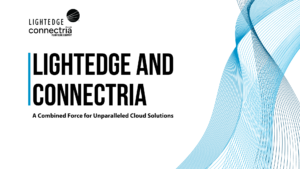Right now, many areas of the United States are experiencing natural disasters. With hurricane season at its peak and tornados, snow, and wildfires affecting other areas of the country, there is no better time to update your disaster recovery plan.
While natural disasters seem to be top of mind right now, not all emergencies come in the form of a storm. Failed air conditioning, broken water pipes, chemical leaks, and security breaches can cause just as much damage. If your business is located in a typically safe geographic location, it is important to remember all of the day-to-day threats that could cause business outages. That is why every business should have a disaster recovery plan.
However, it is important that your disaster recovery plan is tailored to your specific business to ensure that your systems and data are protected. To know that your organization can continue to operate in the event of an actual disaster, here are general guidelines to create a plan that will help you recover quickly.
Foundations for a Good Disaster Recovery Plan
Disaster Recovery is a type of security planning that aims to protect a company and its data in the event of an emergency. A disaster recovery plan allows an organization to continue running or quickly resume mission-critical functions following a disaster.
A disaster recovery plan is a documented set of processes to help your organization minimize disruption during an outage. The plan should include up to date, detailed procedures on what to do before, during and after a disaster. The purpose is to maintain a certain level of stability and have a systematic recovery process after a disaster.
Within the plan, should be a detailed outline of what employees need to do in the event of an emergency, what communication is required between employees and customers, and what time frame in which critical systems need to be reinstated. It is best to include descriptions of key roles and responsibilities, so everyone knows who to go to for what.
Effective disaster recovery planning is about strong communication among different departments, employees, and customers. Failure to continually interact and over-communicate will slow down the recovery process.
Business Impact Analysis Phase
When creating a disaster recovery plan, the foundation to start at is the business impact analysis.
The business impact analysis phase is where companies evaluate the potential effects that critical and non-critical activities may have. This business impact analysis is an essential component that helps bring to light any vulnerabilities. From there, comes the planning component.
The planning portion of a business impact analysis is where businesses develop strategies for minimizing risks of potential disasters. Perceptions of acceptability are affected by the cost or recovery solutions. For each critical function, two values are typically assigned:
- Recovery Point Objective (RPO): the acceptable latency of data that will not be recovered.
- Recovery Time Objective (RTO): The acceptable amount of time it takes to restore the function.
The recovery object must ensure that the maximum tolerable data loss for each activity is not exceeded.
There are no standard guidelines that a business impact analysis must follow, yet there are best practices that many organizations use. The general multi-phase process includes the following steps:
- Gather all relevant information
- Evaluate the collected information
- Prepare a report on its findings
- Present the results to all trusted employees that handle any aspect of your business continuity plan
LightEdge is committed to keeping customers’ IT operations, critical applications, and data protected. We provide the technology and resources our customers require to get back to a production state that meets their RPO and RTO requirements.
The goal of a business impact analysis is to determine the most critical business operations that employees need to function properly. It is also to understand the time frame within which these items need to be recovered for the organization to get back to normal working conditions.
Business impact analysis and threat and risk analysis are two important phases during business continuity planning. The business impact analysis typically takes place prior to the threat and risk analysis because it can serve as a starting point for a disaster recovery strategy. It can also provide a base for examining RPOs and RTOs and other resources that are needed for business continuance.
Backups vs. Disaster Recovery
Many companies believe that backups and disaster recovery planning are the same. While backups are important, it is not disaster recovery.
You cannot have disaster recovery without backups, but you can back up your data without having a disaster recovery plan in place. While it may seem like the cheaper option right out of the gate, it can be quite a dangerous and costly plan in the long run to depend purely on backups.
The term “backup” seems simple enough to most of us. Data backup is the process of storing copies of your data in case of a failure. Whether that failure is due to a machine or human error, it can cause your primary data to disappear or become corrupted. Data recovery happens all the time. Whether an employee deletes a file in error or something happens that requires you to reload your data, the backup serves as the information that you restore.
But in order to restore data, you need to have a place and an environment where the data can reside. This is where disaster recovery comes into play when you have lost your IT environment.
A disaster can be something as large as a hurricane that wipes out your entire data center or as small as temporarily losing power or connectivity to your servers or primary site. A disaster recovery plan enables you to restore functionality and access to your data and systems via a secondary environment, and then transfer it all back to your primary environment after the disaster has ended.
Here are the differences between a backup and disaster recovery planning:
- Backup is the process of saving your data in a secure location (onsite or offsite) to restore a working environment when you need it.
- Disaster recovery is a larger process that replicates your entire computing environment—data, systems, networks, and applications—as part of your business continuity plan and restores it all after the crisis has passed.
Threat and Risk analysis
The threat and risk analysis is the process of defining recovery requirements that each potential threat may require. Common threats to prepare for include:
- Epidemic
- Earthquake
- Fire
- Flood
- Tornado
- Cyber attacks
- Internal or External Sabotage
- Hurricane
- Power outage
- Telecom outage
- IT outage
- Terrorism
- Theft
- Random failure of mission-critical infrastructure
Assessing the threats and risks and finding solutions that prevent or address them with minimal downtime to business is imperative. LightEdge offers a comprehensive set or recovery solutions to ensure uninterrupted performance of IT operations and mission-critical systems in the event of an emergency.
Define Who is Responsible for What
It is important to clearly define the key roles in a disaster recovery plan. These key roles should include the involved parties and their responsibilities during the event of a disaster. The first role that should be defined is who can declare a disaster.
Having a clear list of responsibilities will ensure a universal understanding of what items need to be completed and by whom. This is especially important when it comes to third party vendors. Everyone needs to be aware of each other’s responsibilities to ensure the disaster recovery plan operates optimally.
The key roles section of your disaster recovery plan needs to include who should and how to contact the appropriate parties on the disaster recovery team. It should also include the order in which to contact members of the team to get systems up and running as soon as possible.
Gather their contact information, including an email and phone number. Place this information towards the top of the business continuity plan, so you can get in touch with them in a moment’s notice. Do not waste valuable time searching through a lengthy document.
A final consideration should be a succession plan to train back-up employees in case a key team member is out of the office or leaves your company.
Communication and Roles
Who does what and how to get hold of people are the two most essential needs in the immediate aftermath of a disastrous event. Contact information for all employees and providers essential to disaster recovery needs to be kept up to date and readily accessible. Also, each team and team members’ roles in case of an emergency event must be clearly outlined.
Many times, the main communication platforms, like phone or email, may be affected by the disaster. Be sure to outline alternative methods for contacting employees, third-party vendors or customers.
To keep the public informed, it is important to to publish a statement on you company’s website and social media channels. That way, customers receive timely updates on what they can expect from your organization.
Have Suitable Resources
Managing disaster recovery on your own involves a significant financial investment, dedicated time, and proven expertise. Even larger enterprises must decide how much internal effort to focus on disaster recovery planning vs. growing the business.
Many companies partner with an expert to help with their disaster recovery. A vendor can bring the knowledge and a programmatic approach to ensure your disaster recovery solutions meet the needs of your business and your IT capabilities.
Disaster recovery experts advise that backup data be kept offsite in a secure location, preferably a data center facility that is equipped to handle any disaster. LightEdge recommends the 3-2-1- rule when it comes to backups. You should always have at least 3 independent copies of your data. Store the data on at least 2 types of media. At least 1 of those copies should be kept offsite. Modern technology also offers the option to secure your organization’s data and critical applications in a hosted cloud environment. Either option allows applications and data to be delivered on demand.
Keep Your Disaster Recovery Plan Current
Once your disaster recovery plan is complete, it is time to put it to the test. Testing is considered one of the most important parts of recovery planning. If the plan doesn’t work or is not current, your organization might has well not have one at all.
Without consistent testing and optimization, disaster recovery remains a technological hypothesis. It likely does not account for the contingencies of a real emergency. For companies that never test a disaster recovery plan or only test it once every few years, unproven recommendations could undermine the entire disaster recovery process.
Companies can conduct training for the business continuity team and provide them with testing and different exercises to evaluate each business impact and its corresponding recovery strategy. Be sure to document the results. Performing multiple tests to see how policies hold up and compare is recommended.
Get Started Today
What would happen to your mission critical infrastructure and data if a disaster were to hit this very second? Are you prepared? If not, or if you’re in need of a better disaster recovery solution. Thankfully, LightEdge can help. Now that modern IT practices have started to blend physical with virtual, and cloud with on-premises, safeguarding your applications and data requires several tools and methods.
LightEdge is committed to keeping our customers’ IT operations, critical applications and data protected. We provide the technology and resources our customers require to get back to a production state that meets their RTO and RPO requirements.
LightEdge offers a comprehensive set of disaster recovery solutions to ensure uninterrupted performance of IT operations and mission-critical systems in the event of a disaster.
The reliable availability of business IT is essential to the management and livelihood of every company, large or small. All elements hinge on the dependability of your technology to deliver vital information right when you need it.
Redundancy is built into each of our data centers in Des Moines, Kansas City, Omaha, and newly acquired Austin and Raleigh facilities. Each of our LightEdge facilities strive to deliver more than traditional data centers. We have created true Hybrid Solution Centers designed to offer a complete portfolio of high speed, secure, redundant, local cloud services and managed gateways to public clouds through our hardened facilities.
Want to learn more about LightEdge’s disaster recovery and business continuity services? Contact one of our disaster recovery experts to get started or to schedule your private tour of any of our data center facilities. We have disaster recovery, colocation, and business continuity experts standing by to answer any of your questions.




